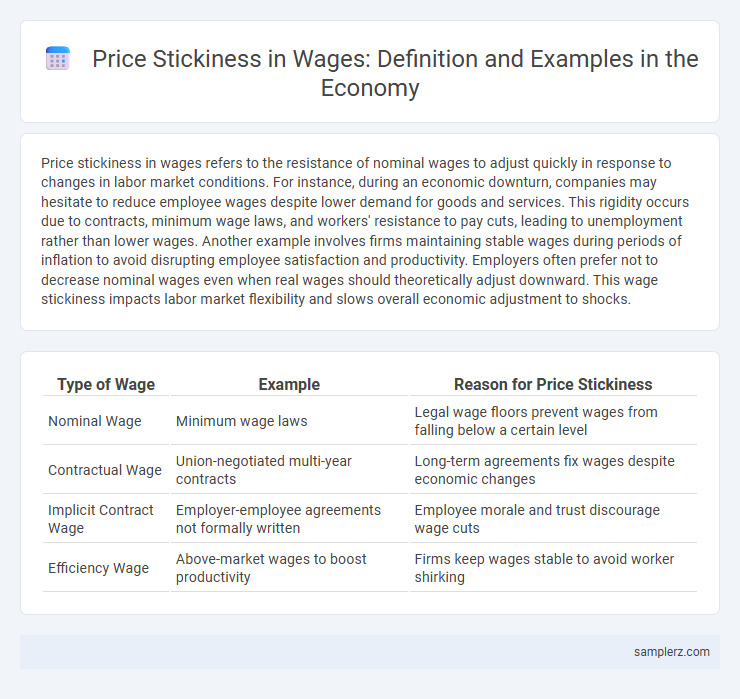Price stickiness in wages refers to the resistance of nominal wages to adjust quickly in response to changes in labor market conditions. For instance, during an economic downturn, companies may hesitate to reduce employee wages despite lower demand for goods and services. This rigidity occurs due to contracts, minimum wage laws, and workers' resistance to pay cuts, leading to unemployment rather than lower wages. Another example involves firms maintaining stable wages during periods of inflation to avoid disrupting employee satisfaction and productivity. Employers often prefer not to decrease nominal wages even when real wages should theoretically adjust downward. This wage stickiness impacts labor market flexibility and slows overall economic adjustment to shocks.
Table of Comparison
| Type of Wage | Example | Reason for Price Stickiness |
|---|---|---|
| Nominal Wage | Minimum wage laws | Legal wage floors prevent wages from falling below a certain level |
| Contractual Wage | Union-negotiated multi-year contracts | Long-term agreements fix wages despite economic changes |
| Implicit Contract Wage | Employer-employee agreements not formally written | Employee morale and trust discourage wage cuts |
| Efficiency Wage | Above-market wages to boost productivity | Firms keep wages stable to avoid worker shirking |
Understanding Wage Stickiness: Key Economic Concepts
Wage stickiness occurs when nominal wages remain rigid despite changes in labor market conditions, leading to slower adjustments in employment levels. Factors such as long-term labor contracts, minimum wage laws, and employee morale concerns contribute significantly to this rigidity. This phenomenon often results in unemployment during economic downturns due to the inability of wages to decrease promptly.
Real-World Cases of Wage Rigidity During Recessions
During the 2008 financial crisis, many companies maintained nominal wages despite falling demand, illustrating price stickiness in labor markets. Research shows that firms often avoid wage cuts to preserve employee morale and reduce turnover costs, even when unemployment rises sharply. This wage rigidity contributed to prolonged unemployment during recessions by limiting labor market adjustments.
Minimum Wage Laws and Their Impact on Wage Flexibility
Minimum wage laws create a legal floor that prevents employers from lowering wages below a set threshold, leading to price stickiness in labor markets. This rigidity limits wage flexibility, especially during economic downturns when labor demand decreases, causing prolonged unemployment or reduced hiring. Empirical studies show that regions with higher minimum wages experience slower wage adjustments compared to markets without such mandates.
Union Contracts as a Source of Price Stickiness in Wages
Union contracts often contribute to wage stickiness by setting fixed wage rates for defined periods, preventing rapid adjustments to labor costs despite changes in market demand or economic conditions. These agreements typically include clauses that guarantee scheduled wage increases and limit employers' ability to reduce wages, reinforcing rigidity in labor expenses. As a result, union-negotiated wages remain relatively inflexible, impacting firms' hiring decisions and overall labor market dynamics.
Downward Nominal Wage Rigidity: Causes and Examples
Downward nominal wage rigidity occurs when employers resist lowering workers' nominal wages despite economic downturns, leading to persistent unemployment and reduced labor market flexibility. Causes include employee morale concerns, contracts with fixed wage floors, and legal minimum wage laws that prevent wage cuts below a specific threshold. An example is during recessions when firms prefer layoffs over wage reductions due to the adverse effects on worker productivity and retention.
Wage Stickiness in the Public vs. Private Sectors
Wage stickiness is prominently observed in the public sector where government regulations and collective bargaining agreements limit wage flexibility, causing slower adjustments compared to the private sector. In contrast, the private sector experiences more dynamic wage changes driven by market competition, though some stickiness remains due to long-term contracts and employee retention strategies. This discrepancy in wage stickiness affects labor market responsiveness and economic policy effectiveness across sectors.
Efficiency Wages and Their Effect on Wage Stability
Efficiency wages contribute to wage stickiness by setting wages above market-clearing levels to boost worker productivity and reduce turnover. Firms paying efficiency wages maintain stable wages even during economic downturns, minimizing incentive to reduce pay despite labor market fluctuations. This practice leads to rigid wage structures that resist downward adjustments, sustaining wage stability and influencing overall employment dynamics.
The Role of Implicit Contracts in Wage Inflexibility
Implicit contracts between employers and employees contribute significantly to wage stickiness by establishing unspoken agreements that discourage frequent wage adjustments despite changing economic conditions. These contracts foster job security and stable income expectations, reducing the likelihood of wage cuts during downturns and limiting wage increases during periods of economic growth. The result is a labor market condition where wages remain rigid, impacting overall economic flexibility and response to shocks.
Wage Stickiness and Unemployment: Connection and Evidence
Wage stickiness occurs when wages remain fixed despite changes in labor market conditions, leading to insufficient adjustments during economic downturns. This rigidity contributes to unemployment as employers reduce hiring or lay off workers instead of lowering wages to balance labor supply and demand. Empirical studies demonstrate that wage stickiness prolongs unemployment spells and impedes labor market recovery after recessions.
International Comparisons of Wage Stickiness Phenomena
Wage stickiness varies significantly across countries, with European labor markets like Germany and France exhibiting higher wage rigidity due to strong labor unions and collective bargaining agreements. In contrast, the United States shows lower wage stickiness, reflecting more flexible labor market policies and weaker union influence. Cross-country studies reveal that institutional factors, such as employment protection laws and social safety nets, are key determinants of international wage stickiness differences.

example of price stickiness in wage Infographic
 samplerz.com
samplerz.com